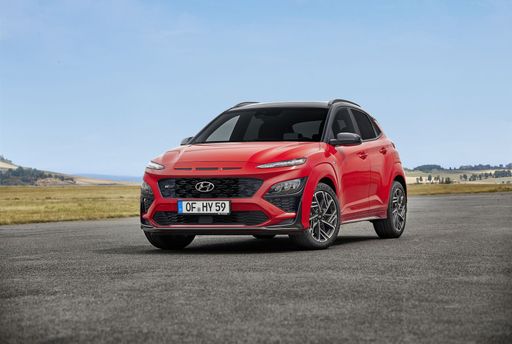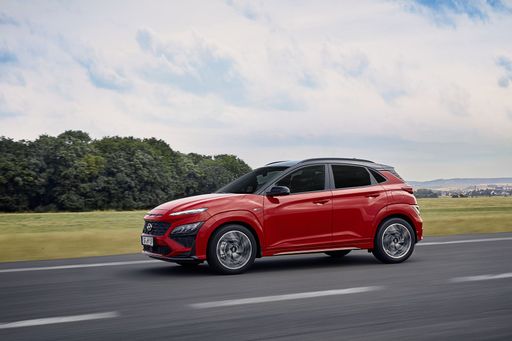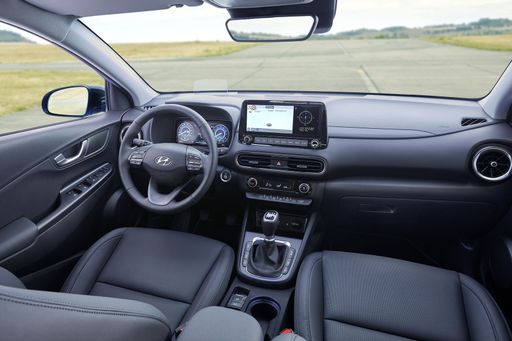Ford Capri vs Hyundai Kona – Differences & prices compared
Both models have their strengths – but which one suits you more?
Compare performance, efficiency, price and space directly: Ford Capri or Hyundai Kona?
Costs and Efficiency:
When it comes to price and running costs, the biggest differences usually appear. This is often where you see which car fits your budget better in the long run.
Hyundai Kona has a significantly advantage in terms of price – it starts at 23100 £, while the Ford Capri costs 36300 £. That’s a price difference of around 13285 £.
In terms of energy consumption, the advantage goes to the Ford Capri: with 13.80 kWh per 100 km, it’s slight more efficient than the Hyundai Kona with 14.60 kWh. That’s a difference of about 0.80 kWh.
As for range, the Ford Capri performs to a small extent better – achieving up to 627 km, about 113 km more than the Hyundai Kona.
Engine and Performance:
Power, torque and acceleration are the classic benchmarks for car enthusiasts – and here, some clear differences start to show.
When it comes to engine power, the Ford Capri has a clearly perceptible edge – offering 340 HP compared to 218 HP. That’s roughly 122 HP more horsepower.
In acceleration from 0 to 100 km/h, the Ford Capri is clearly quicker – completing the sprint in 5.30 s, while the Hyundai Kona takes 7.80 s. That’s about 2.50 s faster.
In terms of top speed, the Hyundai Kona performs somewhat better – reaching 210 km/h, while the Ford Capri tops out at 180 km/h. The difference is around 30 km/h.
There’s also a difference in torque: Ford Capri pulls decisively stronger with 679 Nm compared to 265 Nm. That’s about 414 Nm difference.
Space and Everyday Use:
Beyond pure performance, interior space and usability matter most in daily life. This is where you see which car is more practical and versatile.
Both vehicles offer seating for 5 people.
In curb weight, Hyundai Kona is clearly perceptible lighter – 1370 kg compared to 1914 kg. The difference is around 544 kg.
In terms of boot space, the Ford Capri offers to a small extent more room – 572 L compared to 466 L. That’s a difference of about 106 L.
In maximum load capacity, the Ford Capri performs a bit better – up to 1510 L, which is about 210 L more than the Hyundai Kona.
When it comes to payload, Ford Capri slightly takes the win – 587 kg compared to 490 kg. That’s a difference of about 97 kg.
Who comes out on top?
Overall, the Ford Capri shows itself to be outperforms in nearly all aspects and secures the title of DriveDuel Champion.
It convinces with the more balanced overall package and proves to be the more versatile choice for everyday use.
 @ Ford Motor Company / Ford Media Center
@ Ford Motor Company / Ford Media Center
Ford Capri
Ford Capri
The Ford Capri turned the family car into something cheekily sporty, with a long, rakish profile that still promises fun at a glance. Today it lives on as a lovable classic — easy to tinker with, enjoyable to drive and guaranteed to raise smiles at any meet.
details @ Ford Motor Company / Ford Media Center
@ Ford Motor Company / Ford Media Center
 @ Ford Motor Company / Ford Media Center
@ Ford Motor Company / Ford Media Center
Hyundai Kona
The Hyundai Kona wears its personality on the outside with bold styling and sprightly handling that turns city driving into something a little more fun than a commute. It blends practical space, modern tech and sensible running costs into a compact, stylish package — a smart pick if you want flair without paying luxury prices.
details @ Hyundai Motor Company
@ Hyundai Motor Company
 @ Hyundai Motor Company
@ Hyundai Motor Company
 @ Hyundai Motor Company
@ Hyundai Motor Company
 @ Hyundai Motor Company
@ Hyundai Motor Company
 @ Ford Motor Company / Ford Media Center
@ Ford Motor Company / Ford Media Center
|
 @ Hyundai Motor Company
@ Hyundai Motor Company
|
|
|
|
Costs and Consumption |
|
|---|---|
|
Price
36300 - 50900 £
|
Price
23100 - 41600 £
|
|
Consumption L/100km
-
|
Consumption L/100km
4.6 - 7 L
|
|
Consumption kWh/100km
13.8 - 16.4 kWh
|
Consumption kWh/100km
14.6 - 16.8 kWh
|
|
Electric Range
374 - 627 km
|
Electric Range
377 - 514 km
|
|
Battery Capacity
52 - 79 kWh
|
Battery Capacity
1.3 - 65.4 kWh
|
|
co2
0 g/km
|
co2
0 - 163 g/km
|
|
Fuel tank capacity
-
|
Fuel tank capacity
38 - 47 L
|
Dimensions and Body |
|
|---|---|
|
Body Type
SUV
|
Body Type
SUV
|
|
Seats
5
|
Seats
5
|
|
Doors
5
|
Doors
5
|
|
Curb weight
1914 - 2174 kg
|
Curb weight
1370 - 1773 kg
|
|
Trunk capacity
567 - 572 L
|
Trunk capacity
466 L
|
|
Length
4634 mm
|
Length
4350 - 4385 mm
|
|
Width
1872 mm
|
Width
1825 mm
|
|
Height
1626 mm
|
Height
1580 - 1585 mm
|
|
Max trunk capacity
1505 - 1510 L
|
Max trunk capacity
1300 L
|
|
Payload
570 - 587 kg
|
Payload
420 - 490 kg
|
Engine and Performance |
|
|---|---|
|
Engine Type
Electric
|
Engine Type
Electric, Petrol, Full Hybrid
|
|
Transmission
Automatic
|
Transmission
Automatic, Manuel
|
|
Transmission Detail
Reduction Gearbox
|
Transmission Detail
Reduction Gearbox, Manual Gearbox, Dual-Clutch Automatic
|
|
Drive Type
Rear-Wheel Drive, All-Wheel Drive
|
Drive Type
Front-Wheel Drive, All-Wheel Drive
|
|
Power HP
170 - 340 HP
|
Power HP
115 - 218 HP
|
|
Acceleration 0-100km/h
5.3 - 8.7 s
|
Acceleration 0-100km/h
7.8 - 11.9 s
|
|
Max Speed
160 - 180 km/h
|
Max Speed
162 - 210 km/h
|
|
Torque
310 - 679 Nm
|
Torque
200 - 265 Nm
|
|
Number of Cylinders
-
|
Number of Cylinders
3 - 4
|
|
Power kW
125 - 250 kW
|
Power kW
85 - 160 kW
|
|
Engine capacity
-
|
Engine capacity
998 - 1598 cm3
|
General |
|
|---|---|
|
Model Year
2024 - 2025
|
Model Year
2024 - 2025
|
|
CO2 Efficiency Class
A
|
CO2 Efficiency Class
A, D, C, E, F
|
|
Brand
Ford
|
Brand
Hyundai
|
Is the Ford Capri offered with different drivetrains?
The Ford Capri is offered with Rear-Wheel Drive or All-Wheel Drive.
The prices and data displayed are estimates based on German list prices and may vary by country. This information is not legally binding.
